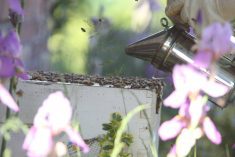MEACHAM, Sask. – Paul Paquet, one of Canada’s leading experts on wolves and bears, has an unlikely home address.
While he has built a career specializing in large carnivores, he has chosen to live where such animals are non-existent.
The wildlife biologist is founder and co-director of the Central Rockies Wolf Project and works with graduate students as a research associate or adjunct professor with the universities of Calgary, Victoria, Alberta, Saskatchewan, Manitoba, Brandon, Guelph and New Brunswick.
He has worked for the Canadian Wildlife Service, World Wildlife Fund and Conservation Biology Institute and sat on British Columbia’s grizzly bear science advisory panel.
Read Also

Heat waves combine sunshine and sinking air
As we continue our look at heat waves, I figured we should first define what they are by looking at the criteria Environment Canada uses to define heat events.
But when Paquet finishes up a field research expedition somewhere in North America or Europe, he doesn’t return home to a major university or a research facility in the Rocky Mountains. Rather, he makes his way to Meacham and the flat farmland of eastern Saskatchewan.
When he is home, a fax machine and the internet keep him in touch with the outside world. As well, the University of Saskatchewan in Saskatoon, with its academic and research facilities, is only 65 kilometres away.
“I can do anything from here that I could do in any city, with a much higher quality of life. It’s a great advantage.”
Paquet was born in Portland, Oregon, and grew up in Fernie, B.C. In the early 1980s, while working for the Canadian Wildlife Service in Manitoba’s Riding Mountain National Park, he met artist Anita Rocamora, who had a home in Meacham.
After living in Banff together for several years, the couple moved to Rocamora’s adopted home in 1994.
Paquet said his decision wasn’t much of a stretch, considering he has spent much of his working life in remote areas and hasn’t lived in a city for 30 years.
There is a lot of demand on his time when working with students, and he likes being able to retreat to Meacham where he can find solitude and a degree of isolation.
As a scientist dedicated to preserving Canada’s large carnivore populations, he is disturbed by the ecological damage inflicted on the Prairies, but he also appreciates the region’s beauty and subtlety.
As well, he said living within Meacham’s artist colony has its professional advantages.
“I think I’m a far, far, far better biologist than I ever would have ever been because of that exposure,” he said.
“It allows me to really think far more creatively, without that tunnel vision that I think really afflicts scientists. It has forced me to use more of my mind than I’ve really been trained to do.”














